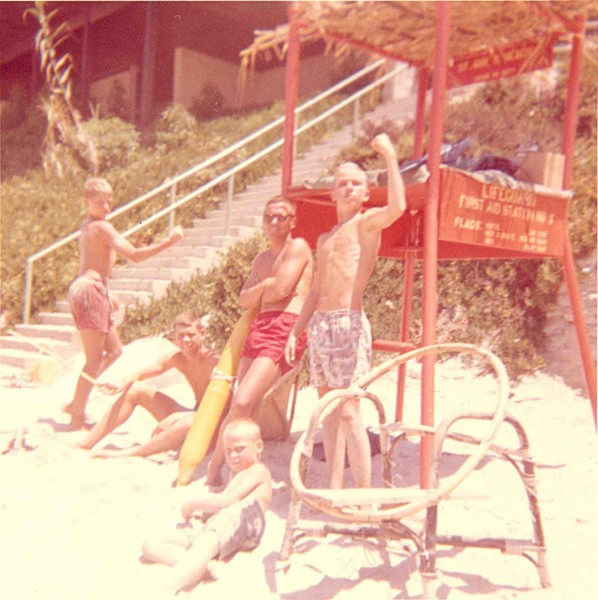By Dale Ghere, Special to the Independent
The first metal towers
Around 1958, Chief Lifeguard Art Fizette decided lifeguards needed to be up off the beach for improved observation since annual beach attendance kept increasing, remembers Craig Lockwood, who also guarded in the ‘50s.
Fizette’s initiative won the grudging approval of the former city manager, Jim Wheaton. He provided the most rudimentary of instructions on how the towers should be built to Clyde Sweetzer, who then headed the parks department. “Keep’em cheap and get the things off the beach after Labor Day with no more than four or five guards.”
Sweetzer turned for advice to a friend, former Laguna Beach lifeguard Danny Shull, who then was a city building department inspector. Shull was given the job of designing a sturdy, metal tower that would come in under budget for something like $75 for labor and materials.
“Shull confided to me that the design specifications other than the ‘four or five man’ portability factor were fairly vague,” Lockwood said. He spent an hour drafting a structurally simple, sturdy, geometrically base-balanced frame, economically composed of three, nine-foot galvanized pipes and one 12-foot upright, braced horizontally on all four sides and a six-foot wide deck.
The design included a guardrail open to the ocean side of the tower and the 12-foot upright providing a short flagpole for surf-condition flags and a telephone line. A second set of cross bars held a lockable equipment storage box. “The whole thing was fairly bullet-proof,” Lockwood said, and allowed a lifeguard to plant a large umbrella in the flagpole stub and adequate space for a beach chair, rescue tube, first aid kit, fins and telephone. It was painted with rust-inhibiting red-lead paint.
“Everything was laid out in terms so structurally simple that even a lifeguard could build this framework if he had rudimentary welding skills,” said Lockwood, who with Eugene de Paulis over the years built eight towers, replacing the old ones that eventually rusted through.
My first year on the beach
Since 1958, lifeguards scanned the sands from these metal towers. In 1960, I remember metal towers at Shaws, Diver’s, Picnic, Boys Club, Los Andos, Sleepy Hollow, St Ann’s, Oak Street, Mountain Road, Pearl, Woods Cove and Victoria. Crescent Bay had two towers. Main Beach guards used a bench on the platform in front of the Main Beach tower.

Before Easter Week each year the 250-pound towers had to be moved from storage in the canyon to the beach.Carrying a tower up and down the beach-access steps is no easy trick. At least 25 people have filed worker’s compensation claims over the years from carrying towers, according to current lifeguard chief, Mark Klosterman.
Because of the difficulty and danger of moving the heavy towers on and off the beach each year several attempts were made to concrete some of the towers in place. All of these attempts proved futile. Corrosion and high surf conditions destroyed every tower that was left on the beach.
The towers had to be strong, stable and durable to withstand the rigors of hard use. Light-weight towers have been tried, but they did not hold up. During the latter part of the ‘60s, guards were needed at some of the smaller beaches, such as Rock Pile, Boat Canyon and Moss Street. Because these beaches lacked sand, no towers were built at first. Supervisors found that this provided the perfect opportunity for the local girls to sit next to the guard, who usually camped on the steps. Special towers soon followed.
Tans and Cancer
The common wisdom of the ‘60s held that slathering with baby oil or coconut oil produced the best tan. That stuff was useless. Since guard towers lacked shade, I got really fried the first week. I knew I was in trouble when I kissed my girl friend and saw the end of my nose stuck to her cheek. I bought a better hat the next day and started wearing a jacket and pants more often. I covered the top of my tower with palm fronds, but the bosses frowned on my ingenuity and made me take it down. Over time, umbrellas, used to block the wind as much as for sun protection, became part of the standard equipment issued guards.
Falling prey to the mystique of cultivating the deepest tan on the beach turns out to be a guard’s biggest hazard. Guards started learning that tans could lead to serious skin problems during the ‘70s. Unfortunately, avoiding the hazard was left up to the individual guard. Even as worker safety regulations became law in other professions, little was done to provide solar protection for guards in Laguna. At least 20 guards have filed worker’s compensation claims related to skin cancer over the years, Klosterman said.
Times have changed. We now know that there is a direct relationship between solar energy and skin cancer. Whatever new towers are deployed, solar protection is imperative. Try looking at the water from a tower during the summer on a clear, glassy, sunny day between 4 and 6 p.m. and you will get an idea why.




